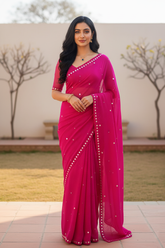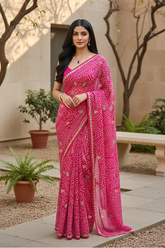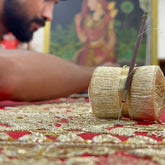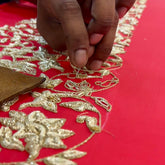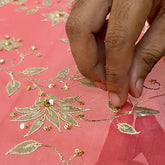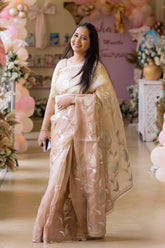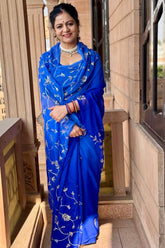Aari Taari – The Jewel of Embroidery
The Living Thread Between History and Contemporary Fashion
In the vast lexicon of Indian handcrafts, Aari-Taari stands apart: a technique at once swift and meticulous, unshowy yet opulent, intimate yet monumental in cultural weight. Its signature — a continuous, hooked-needle chain stitch — renders motifs with the fluidity of ink and the permanence of thread. Once the language of royal ateliers and palace wardrobes, Aari today inhabits couture runways, bridal trousseaus, and considered everyday pieces, its vitality sustained by designers and patrons who understand each stitch as more than ornamentation: it is livelihood, memory, and lineage.
Origins and the Logic of the Hook
The craft’s genealogy reads like a migration of tools and intent. What began in medieval artisan pockets — where hooked needles embellished leather and utility textiles — matured into a refined thread-painting technique. The aari, a penlike hook, works above the fabric while the thread is guided from below; this two-hand choreography yields continuous chain stitches with remarkable speed and tonal subtlety. The result is a surface that reads as drawn, a stitched painting where petals, vines and arabesques flow without interruption.
Under Mughal patronage, the technique found its most luminous expression. Silks, velvets and brocades received dense floral arabesques, paisleys and naturalistic tableaux in gold and silver thread. Courtly aesthetics widened the palette of motifs and elevated Aari to a language of power and refinement. As the craft moved through regions — into Rajasthan, Kashmir, Gujarat, and the eastern provinces where it intersected with karchobi and related styles — it absorbed local grammars: the angular exuberance of Kutch, the lyrical vines of Kashmir, the graphic geometry of Gujarat.
Technique, Materials and the Aesthetics of Restraint
Aari is deceptively simple in apparatus and infinitely complex in execution. The instrument is modest: a hooked needle affixed to a handle, a wooden frame (adda) to maintain tension, and spools of thread. Within that economy, the artisan composes with extraordinary discipline: chain loops compressed into dense relief, elongated stitches that suggest movement, and delicate fillings that mimic brushwork. Variants — bal-taka twists, lote elongations, jali lattices — expand the vocabulary, while sequins, beads and kundan introduce tactile luminosity.
Traditionally, precious metals defined the craft’s opulence; contemporary practice balances that legacy with pragmatic materials — gilt copper wires, silk floss and synthetic metallic yarns — to make the work viable for broader markets while preserving its visual integrity. The aesthetic strategy most successful contemporary designers employ is restraint: a single, impeccably worked motif on a flowing saree; a measured border on a jacket; a whisper of vines across a kaftan. It is in that restraint that Aari reveals its modernity — the handcrafted accent that reads as deliberate, not decorative.
Cultural Resonance: Ritual, Memory, Heirloom
Aari is woven into the rituals of life. Bridal lehengas and dupattas embroidered in Aari become talismans — garments that carry blessings of prosperity and continuity. Shawls and stoles, worked in whispered stitches, migrate from shoulders to family altars as heirlooms, their fabric softened by wear but their embroidery intact, carrying generations in thread.
Regionally, the craft is an archive of identity: Rajasthan’s bold motifs signal celebration; Kashmir’s delicate floral runs evoke landscape and intimacy; Gujarat’s geometric juxtapositions echo community narratives. Beyond aesthetic value, Aari sustains social ecologies: familial apprenticeships, cooperative clusters, and the quiet economies of small workshops where skill is currency and continuity a vocation.
Contemporary Applications: From Bridal Theatrics to Quiet Luxury
Aari’s adaptability is one of its greatest strengths. Bridal couture remains its most embroidered canvas — panels of lehengas, ornate pallus, and cholis mapped out in complex chain stitch. Yet Aari also migrates gracefully into contemporary wardrobes: demure blouses with an embroidered back, a silk kaftan edged with restrained vinework, a structured jacket where Aari appears as an artisan’s signature on a lapel. Home textiles and accessories — clutches, cushions, wall panels — create new markets, allowing the craft to be experienced beyond ceremonial use.
The contemporary imperative is to position Aari as a mark of considered luxury: visible, intelligible, and narratively anchored. Designers who use it sparingly and thoughtfully maintain its value and ensure the artisan’s labour is legible.
Threats to Continuity and Paths to Sustainment
Aari faces the familiar pressures that beset traditional crafts: mechanized embroidery, cost-driven supply chains, and the migration of younger artisans to urban economies. Material inflation and market volatility compound the precarity. Preservation therefore demands more than nostalgia; it requires structural interventions: fair procurement models, design collaborations that respect technique, training programs, market platforms that communicate provenance, and branding that restores economic value to handwork.
Sustainable futures for Aari are built on partnerships — between designers, cooperatives, NGOs and discerning clients — that translate appreciation into predictable livelihoods.
A New Custodianship: Umaid Couture’s Commitment
In this fragile constellation of craft and commerce, Umaid Couture has chosen a custodial path. Their approach is not appropriation but stewardship: to craft garments that bear the unequivocal imprint of the artisan’s hand and to orient the marketplace toward ethical recognition.
The house’s design philosophy privileges dialogue with makers. Pieces are conceived with the adda in mind — a saree, a kaftan, a bridal panel, or a streamlined jacket — each calibrated so that the Aari work remains visible, wearable and dignified. Collections highlight Aari as a focal language rather than a surface treatment, ensuring the craft’s visual poetry remains central.
Behind the label is a concrete practice: direct engagement with artisan clusters, consistent commissions that stabilize incomes, and storytelling that returns authorship to the makers. By framing Aari within contemporary silhouettes — not as an archival curiosity but as a living grammar of luxury — Umaid Couture helps preserve the craft’s social infrastructure while widening its cultural currency.
Epilogue: The Future Sewn in Quiet Hands
Aari-Taari is more than a technique; it is an ethic. It asks things of us that modern production often forgets: patience, reverence, and a willingness to honor labour with value. The craft’s survival depends on consumers and creators willing to participate in a different economy — one where time is priced, stories are told, and hands are credited.
At the close of this narrative, it is fitting to name those who choose stewardship as vocation. Umaid Couture — through the vision and advocacy of its founders, Gaj Singh Bhati and Capt. Shubhangini Ranawat — exemplifies a contemporary model of preservation: elegant in design, rigorous in craft, and uncompromising in respect for the hands that keep Aari alive. Their work is an invitation to the fashion world: to wear, to value, and to ensure that these living stitches continue to bind India’s past to its future.

